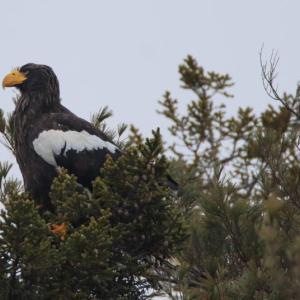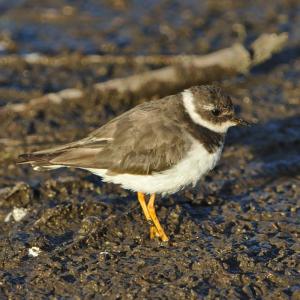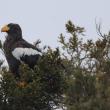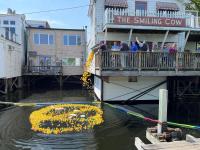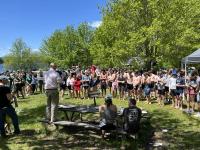Rare Steller’s Sea-eagle Has Returned to Maine
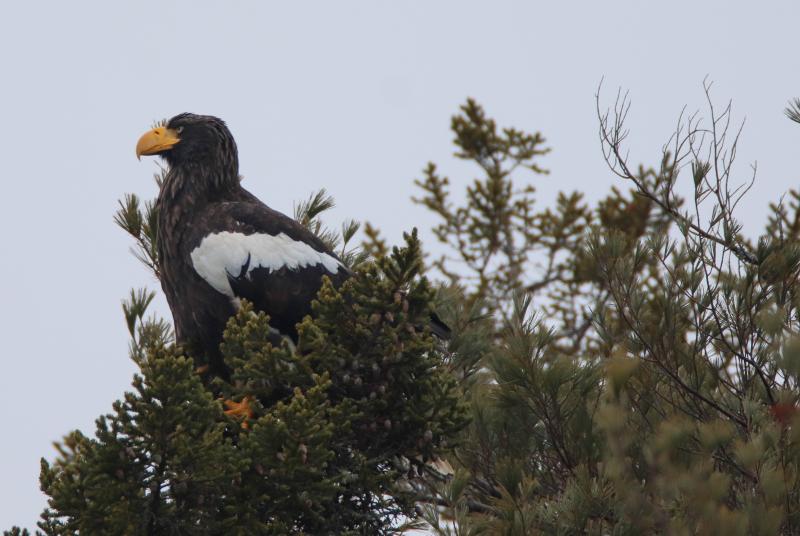 The famed Steller's sea-eagle has returned to Maine as of early February. The bird has been remaining quite distant from observers so there are few good photos from this year’s visit. This photo was taken when the bird was at Five Islands last winter. Courtesy of Zachary Holderby.
The famed Steller's sea-eagle has returned to Maine as of early February. The bird has been remaining quite distant from observers so there are few good photos from this year’s visit. This photo was taken when the bird was at Five Islands last winter. Courtesy of Zachary Holderby.
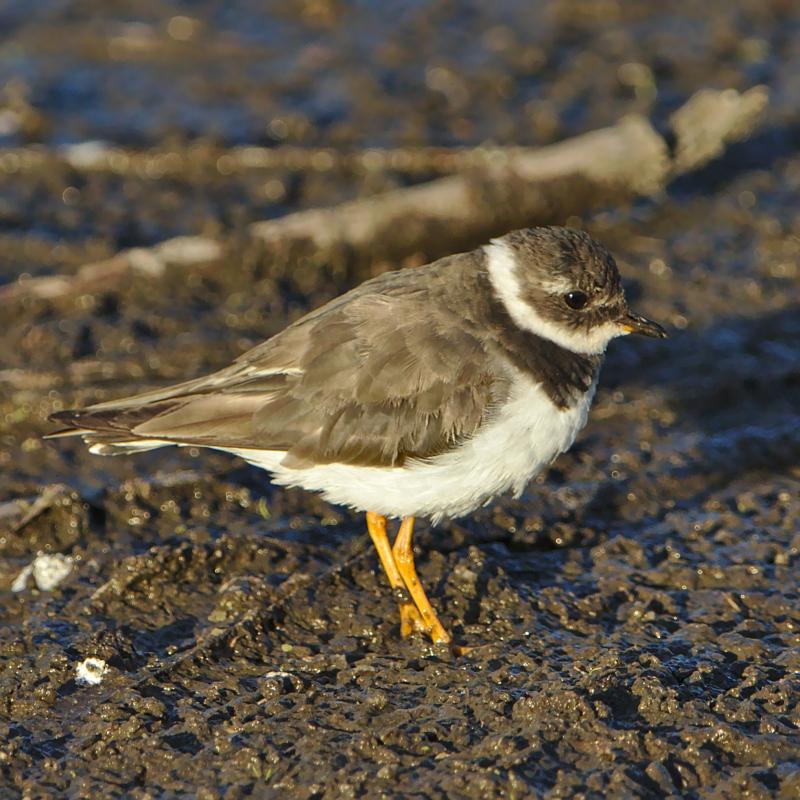 Common ringed plovers are very hard to tell apart from the semipalmated plover, which are common in spring and fall migration here in Maine. Identification requires careful study including noting the color of the eye ring and whether or not there is webbing between the inner toes (no webbing makes it a ringed plover). This photo is of a wintering common ringed plover in Africa. Photo by Derek Keats courtesy Wikemedia Commons.
Common ringed plovers are very hard to tell apart from the semipalmated plover, which are common in spring and fall migration here in Maine. Identification requires careful study including noting the color of the eye ring and whether or not there is webbing between the inner toes (no webbing makes it a ringed plover). This photo is of a wintering common ringed plover in Africa. Photo by Derek Keats courtesy Wikemedia Commons.
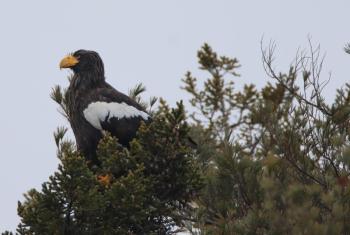 The famed Steller's sea-eagle has returned to Maine as of early February. The bird has been remaining quite distant from observers so there are few good photos from this year’s visit. This photo was taken when the bird was at Five Islands last winter. Courtesy of Zachary Holderby.
The famed Steller's sea-eagle has returned to Maine as of early February. The bird has been remaining quite distant from observers so there are few good photos from this year’s visit. This photo was taken when the bird was at Five Islands last winter. Courtesy of Zachary Holderby.
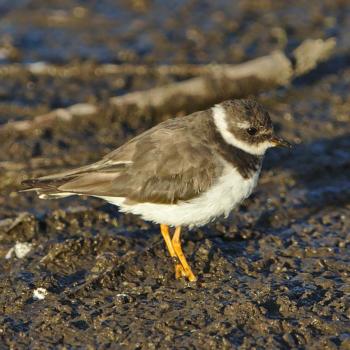 Common ringed plovers are very hard to tell apart from the semipalmated plover, which are common in spring and fall migration here in Maine. Identification requires careful study including noting the color of the eye ring and whether or not there is webbing between the inner toes (no webbing makes it a ringed plover). This photo is of a wintering common ringed plover in Africa. Photo by Derek Keats courtesy Wikemedia Commons.
Common ringed plovers are very hard to tell apart from the semipalmated plover, which are common in spring and fall migration here in Maine. Identification requires careful study including noting the color of the eye ring and whether or not there is webbing between the inner toes (no webbing makes it a ringed plover). This photo is of a wintering common ringed plover in Africa. Photo by Derek Keats courtesy Wikemedia Commons.
The Steller’s sea-eagle is back! We have to assume that, unless you live under a rock, you well remember the flurry of excitement last winter when one of the largest flying birds in the world made its way to Maine. We wrote about it in our column last year. It spent significant time on the Boothbay peninsula, and the numbers of people who braved icy cold conditions to try to see and photograph the bird had to be seen to be believed!
The bird’s massive bright yellow bill, big white wing patches, white tail, and unbelievable size make it a memorable sight. The fact that Steller’s sea-eagle’s natural range is in Russian Siberia south in winter to South Korea and northern Japan, and that they have a small global population size, also makes them a very special bird.
After some time around Boothbay Harbor last winter, this Steller’s sea-eagle bopped over to the nearby Pemaquid peninsula for a bit and then settled in over along the Back River between Arrowsic and Georgetown. It was last seen there in late March of 2022.
By early April the bird had been spotted in Nova Scotia and then it was spotted in southern Newfoundland in late April. It scooted around Newfoundland, seen occasionally and briefly, but in July and August it became a sensation among birders in southeastern Newfoundland when it stayed put for a month or so. The bird was next spotted in October on Saint Pierre and Miquelon, small islands off southern Newfoundland that are overseas territories of France. In late November, the sea-eagle was found along the coast of New Brunswick.
Then it disappeared again.
That is, until a few days ago when it was spotted along the Back River between Arrowsic and Georgetown, where it had delighted birders last winter. Crowds of birders and Steller’s sea-eagle enthusiasts showed up quickly, and its locations and habits are again being well documented.
For fun, we took a look at eBird to see where else Steller’s sea-eagles are being seen at the moment. Most are in northern Japan (Hokkaido) with a few farther south in Japan and a scattering across South Korea including several sightings just miles from the border with North Korea. Who would have thought that a wayward sea-eagle could provide such a great lesson in world geography!
Another wayward bird in Maine has had a much sadder ending. A common ringed plover, a Eurasian twin to the familiar semipalmated plover that we see here in Maine in spring and fall migration, was discovered in late January in southern Maine at Timber Point, Rachel Carson National Wildlife Refuge, between Biddeford Pool and Goose Rocks Beach. What was probably the same bird had been found in Nova Scotia in early January. This is Maine’s third record of this species, although the two previous records were in the August-September time period, at the height of shorebird migration. The middle of winter is certainly not when we would expect a bird like this to appear.
Many birders were able to see the bird over the last week or so but, unlike the sea-eagle that is apparently finding food and staying healthy, the plover was probably not well-suited to deal with the Arctic freeze Maine experienced over the weekend. It was found dead on the beach within days of those ultra-cold temperatures.
These two species are great reminders that while rare birds that show up unexpectedly are a delight for birders to see and marvel at, the reasons for their visits are often complex, and not always in their own best interest. Documenting their movements and population changes will be increasingly important in rapidly changing world.
Jeffrey V. Wells, Ph.D., is a Fellow of the Cornell Lab of Ornithology and Vice President of Boreal Conservation for National Audubon. Dr. Wells is one of the nation's leading bird experts and conservation biologists. He is a coauthor of the seminal “Birds of Maine” book and author of the “Birder’s Conservation Handbook.” His grandfather, the late John Chase, was a columnist for the Boothbay Register for many years. Allison Childs Wells, formerly of the Cornell Lab of Ornithology, is a senior director at the Natural Resources Council of Maine, a nonprofit membership organization working statewide to protect the nature of Maine. Both are widely published natural history writers and are the authors of the popular books, “Maine’s Favorite Birds” (Tilbury House) and “Birds of Aruba, Bonaire, and Curaçao: A Site and Field Guide,” (Cornell University Press).

